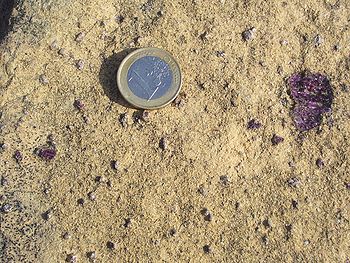
Porphyroblast
Encyclopedia


Mineral
A mineral is a naturally occurring solid chemical substance formed through biogeochemical processes, having characteristic chemical composition, highly ordered atomic structure, and specific physical properties. By comparison, a rock is an aggregate of minerals and/or mineraloids and does not...
crystal
Crystal
A crystal or crystalline solid is a solid material whose constituent atoms, molecules, or ions are arranged in an orderly repeating pattern extending in all three spatial dimensions. The scientific study of crystals and crystal formation is known as crystallography...
in a metamorphic rock
Metamorphic rock
Metamorphic rock is the transformation of an existing rock type, the protolith, in a process called metamorphism, which means "change in form". The protolith is subjected to heat and pressure causing profound physical and/or chemical change...
which has grown within the finer grained groundmass
Matrix (geology)
The matrix or groundmass of rock is the finer grained mass of material in which larger grains, crystals or clasts are embedded.The matrix of an igneous rock consists of finer grained, often microscopic, crystals in which larger crystals are embedded. This porphyritic texture is indicative of...
. Porphyroblasts are commonly euhedral
Euhedral
Euhedral crystals are those that are well-formed with sharp, easily recognised faces. Normally, crystals do not form smooth faces or sharp crystal outlines. Many crystals grow from cooling liquid magma...
crystals, but can also be partly to completely irregular in shape.
The most common porphyroblasts in metapelite
Pelite
Pelite is old and currently not widely used field terminology for a clayey fine-grained clastic sediment or sedimentary rock, i.e. mud or mudstone. It is equivalent to the Latin-derived term lutite. More commonly, metamorphic geologists currently use pelite for a metamorphosed fine-grained...
s (metamorphosed mudstone
Mudstone
Mudstone is a fine grained sedimentary rock whose original constituents were clays or muds. Grain size is up to 0.0625 mm with individual grains too small to be distinguished without a microscope. With increased pressure over time the platey clay minerals may become aligned, with the...
s and siltstone
Siltstone
Siltstone is a sedimentary rock which has a grain size in the silt range, finer than sandstone and coarser than claystones.- Description :As its name implies, it is primarily composed of silt sized particles, defined as grains 1/16 - 1/256 mm or 4 to 8 on the Krumbein phi scale...
s) are garnet
Garnet
The garnet group includes a group of minerals that have been used since the Bronze Age as gemstones and abrasives. The name "garnet" may come from either the Middle English word gernet meaning 'dark red', or the Latin granatus , possibly a reference to the Punica granatum , a plant with red seeds...
s and staurolite
Staurolite
Staurolite is a red brown to black, mostly opaque, nesosilicate mineral with a white streak.-Properties:It crystallizes in the monoclinic crystal system, has a Mohs hardness of 7 to 7.5 and a rather complex chemical formula: 2Al94O204...
s, which stand out in well foliated
Foliation (geology)
Foliation is any penetrative planar fabric present in rocks. Foliation is common to rocks affected by regional metamorphic compression typical of orogenic belts. Rocks exhibiting foliation include the standard sequence formed by the prograde metamorphism of mudrocks; slate, phyllite, schist and...
metapelites (such as schist
Schist
The schists constitute a group of medium-grade metamorphic rocks, chiefly notable for the preponderance of lamellar minerals such as micas, chlorite, talc, hornblende, graphite, and others. Quartz often occurs in drawn-out grains to such an extent that a particular form called quartz schist is...
s) against the platy mica
Mica
The mica group of sheet silicate minerals includes several closely related materials having highly perfect basal cleavage. All are monoclinic, with a tendency towards pseudohexagonal crystals, and are similar in chemical composition...
matrix.
A similar type of crystal is a phenocryst
Phenocryst
thumb|right|300px|[[Granite]]s often have large [[feldspar|feldspatic]] phenocrysts. This granite, from the [[Switzerland|Swiss]] side of the [[Mont Blanc]] massif, has large white [[plagioclase]] phenocrysts, [[triclinic]] [[mineral]]s that give [[trapezium|trapezoid]] shapes when cut through)...
, a large crystal in an igneous rock
Igneous rock
Igneous rock is one of the three main rock types, the others being sedimentary and metamorphic rock. Igneous rock is formed through the cooling and solidification of magma or lava...
. Porphyroblasts are often confused with porphyroclast
Porphyroclast
thumb|350px|right|A [[mylonite]] showing a number of porphyroclasts: a clear red [[garnet]] left in the picture while smaller white [[feldspar]] porphyroclasts can be found all over...
s, which can also be large outstanding crystals, but which are older than the matrix of the rock.
A rock which has many porphyroblasts is described as having a porphyroblastic texture.
As porphyroblasts grow, the foliation may be preserved as oriented inclusions trapped by the porphyroblast as it overgrows them, and this is helpful for tracking changing deformation planes.
In metamorphic rocks that experience deformation during metamorphism, porphyroblasts may grow before, during, or after the phase of deformation recorded by the matrix minerals. The relationship of porphyroblast growth to deformation is typically evaluated by comparing the shape orientation of trails of mineral inclusions in the porphyroblast to the matrix fabric.
Some garnet porphyroblasts contain various curving trails of quartz and other mineral inclusions. The question of whether porphyroblasts (and garnet in particular) rotate during metamorphism and deformation has long been the subject of debate. Research indicates porphyroblasts do not rotate. As they grow, the foliation is preserved in their crystal structure, which is helpful for tracking changing deformation planes.

